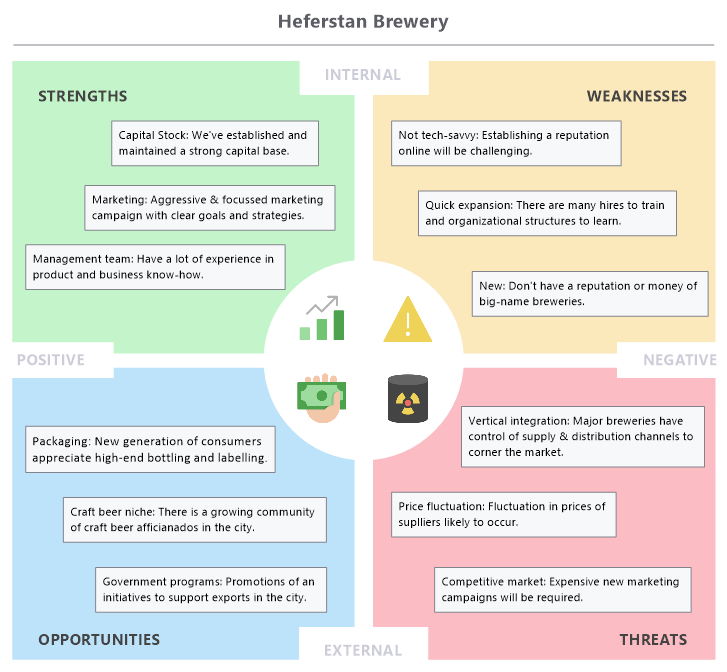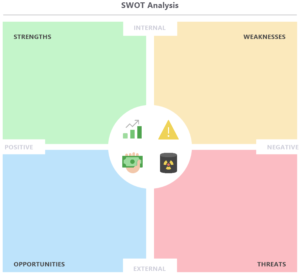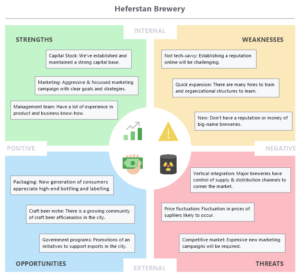By: Nicholas Mistretta
If you’ve never heard of a SWOT analysis, you may not be alone. The good news is that after you see what it is, how you use it, and how to conduct one, it’s going to seem very logical and self-explanatory.
Before we begin, imagine yourself standing in front of a swimming pool. What do you look for before diving into the pool? First, you make sure it has water in it. You make sure it’s deep enough. You ask yourself if it’s clean enough to swim in. And you may even consider the weather; a lightning storm is a bad time to go swimming. This is the point of conducting a SWOT analysis.
What is a SWOT analysis?
A SWOT analysis is a diagram that you can use in your business planning and analysis processes to discover if it’s beneficial (or hazardous) to move forward with a business venture or a particular business strategy. It focuses on pros and cons, positives, and negatives.
SWOT is short for Strengths, Weaknesses, Opportunities, and Threats. Strengths and weaknesses are internal factors, while opportunities and threats are external factors. In your SWOT diagram, you will create one box for each of those four areas.
A quick warning: If you’re going through the trouble of conducting a SWOT analysis, don’t ignore it after you do. A SWOT analysis removes the guesswork and eliminates the need to rely on gut instinct, even when it gives you bad news that you don’t want to hear.
How to use a SWOT analysis
Your SWOT diagram analyzes your project or business venture using each of the four factors above:
- Strengths
- Weaknesses
- Opportunities
- Weaknesses
A SWOT analysis consists of four boxes for each of these factors, but the exact shape can vary. Though, if this is your first SWOT analysis, a simple square diagram will make the most sense.
Conducting a SWOT analysis will help you visualize the pros and cons of any business venture or project by outlining all positives and negatives in clearly defined ways. Deciding whether you should move forward or not should be easier.
How to conduct a SWOT analysis
Let’s first define each of our four factors, then we’ll build our diagram.
1. Strengths
What part of your business or project is doing well? Where do your strengths lie? These are your critical success factors and aspects of your business that are strong and that give you a competitive edge. It is important to recognize these assets and leverage ways to build upon these strengths to grow your business.
2. Weaknesses
You have to identify your business’ weaknesses to improve upon them. What factors put you at a disadvantage when compared to competitors? After you identify them, it’s important to take action to lessen their impact. This step in the SWOT analysis requires an honest and candid analysis of what isn’t working well in your organization.
3. Strengths
Identify the opportunities that are available for your business by pinpointing openings in the marketplace that you can take advantage of to help grow your business. These are caused by external factors like market fluctuations and trends. It’s important that you consider your strengths and weaknesses when assessing opportunities and always ask yourself if the opportunities you do find are right for this time.
4. Threats
In this step, you want to identify threats and find ways to lessen or eliminate them. Market fluctuations, government regulations, and public perception are all external factors that may affect your business in negative ways. Just like you did with strengths, you’ll want to consider strengths and weaknesses when assessing threats. How you respond to the threats you identify is critical.
When conducting your SWOT analysis, you might find that a strength for one part of your organization may be a weakness for another. Consider how brand image and a 100-year-old history of a company may benefit the farm equipment division, while also being a negative for the new technology division.
For this reason, performing a SWOT analysis for each area of your business may be more beneficial than performing just one for your business as a whole.
You might also have the same factors listed in more than one area of your SWOT diagram. For instance, a lack of presence in a particular marketplace could be both a weakness and an opportunity to break into a new marketplace.
SWOT analysis tips
These four tips will help you as you conduct your first SWOT analysis and build your first SWOT diagram.
- Keep your SWOT diagram brief and to the point. Only include the most relevant details in each area. Don’t get bogged down with too much information or explanation in the diagram. You can always go into more detail later in meetings or reports.
- Get feedback when conducting your SWOT analysis. Use the opinions of employees, partners, and customers to get a more varied perspective. A variety of perspectives will contribute to a more thorough SWOT analysis.
- Keep the core objectives of your company’s business plan in mind at all times while performing your SWOT analysis. This will help guide you through all of the internal and external factors that may seem unrelated.
- Arrange the results of your SWOT analysis by order of most important to least important when building your SWOT diagram. This will help you prioritize all action points moving forward.
How to build a SWOT diagram
- First, determine your objective – decide on a key project or strategy to analyze in your SWOT analysis diagram and write it at the top of your page.
- Next, create a grid. Draw a large square and divide it into four smaller squares. If you are using a SWOT diagramming program, the SWOT analysis template will probably do this for you.
- Label the four boxes. The two on the top: Strengths and Weaknesses. The two on the bottom: Opportunities and Threats.
- Label the top of the diagram as Internal Factors. Label the bottom of the diagram as External Factors. Label the left side of the diagram as Positive Factors. And label the right side of the diagram as Negative Factors. Then enter the factors into each of the applicable boxes in bullet form.
- Continue to add, remove, or edit factors as you work through the process.
That’s it. You are now done at this point. It’s time to draw conclusions by analyzing the data on your completed SWOT analysis diagram and ask yourself:
Do the positive outcomes outweigh the negative outcomes?
If your answer is yes, carry out the objective of the business or project. If your answer is no, some adjustments may need to be made or you may have to change the scope of your objective.
Example of a SWOT analysis diagram
This SWOT analysis is for the fictional Heferstan Brewery in your city of choice. You’ll use it to decide if you should move forward with this business venture.

The beauty of a SWOT analysis diagram is that it provides an overview allowing you to quickly decide if the left side outweighs the right side – launch the project or business objective. Or if the right side outweighs the left – do NOT launch the project or business objective.
The SWOT analysis moving forward
Like many aspects of business, a SWOT analysis isn’t a one-time thing. Keep your SWOT analysis in a handy place for easy access in the future. You will have to decide how often to revisit your analysis.
Some people prefer to keep an ongoing SWOT analysis and provide updates to the diagram on a regular basis as factors change. Others prefer to revise the SWOT analysis quarterly or annually. Whatever you decide, keeping it stagnant is a recipe for failure and not recommended.
Downloadable SWOT analysis templates from MindManager
Click the images below to access the SWOT analysis example shared above, and a blank template created using MindManager. Click “Menu” in the bottom left corner of your browser window, and then click “Download” to get a copy of the template. Open the template in MindManager to start working.
Don’t have MindManager? No worries! Try it free for 30 days.



